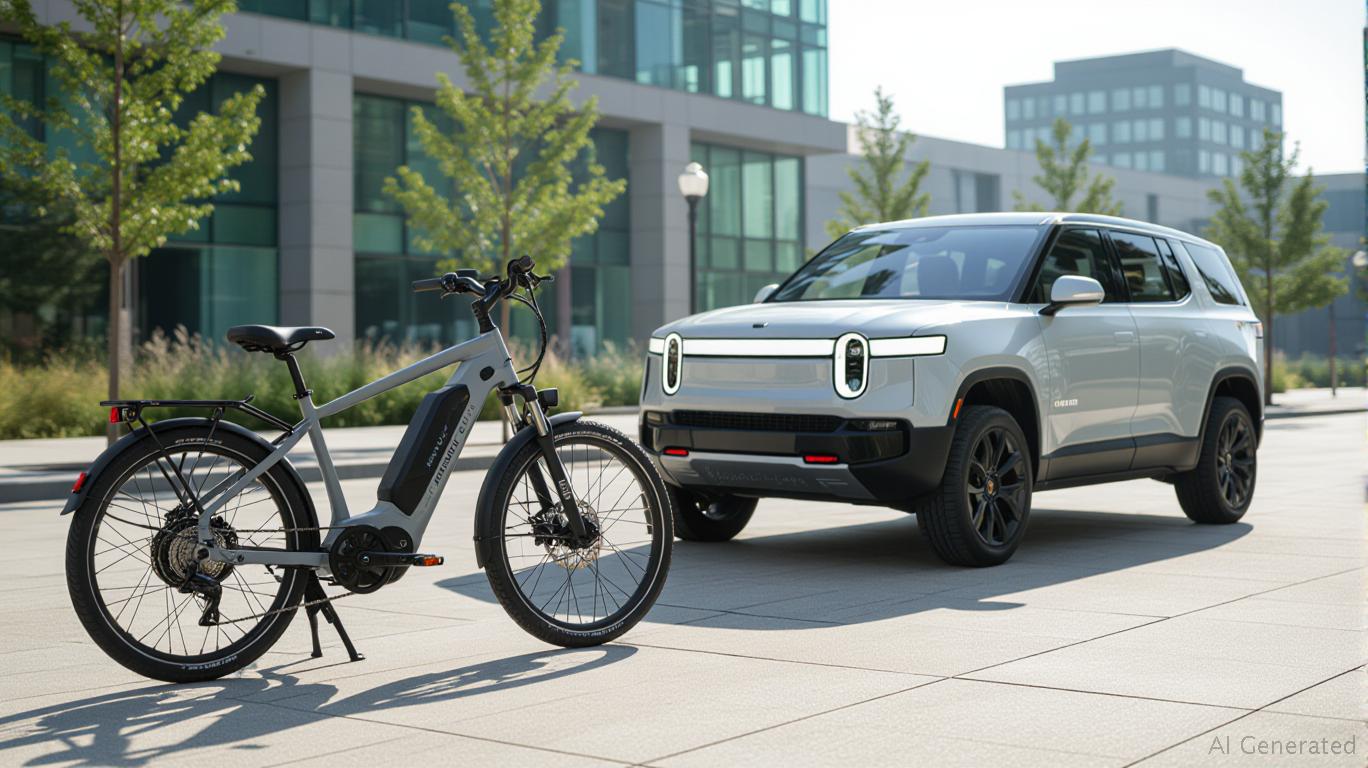In March 2025, Rivian Automotive made a bold strategic move by spinning off its micromobility division into Also, Inc., a $1 billion-valued startup focused on small electric vehicles (EVs) like e-bikes, scooters, and cargo bikes. This decision marks a pivotal shift in Rivian's strategy, allowing the company to concentrate on its core automotive business while positioning Also to capitalize on a rapidly growing market. For investors, the spinoff raises critical questions: How does this reorganization benefit Rivian's long-term prospects? Can Also Inc. carve out a profitable niche in a crowded EV sector dominated by Chinese manufacturers? And what risks accompany this high-stakes pivot?

Strategic Rationale: Focus and Flexibility
Rivian's spinoff of Also Inc. reflects a calculated effort to streamline operations and prioritize its core automotive products—the R1 SUV, R2 midsize SUV (priced at $45,000, targeting Tesla's Model Y), and R3 crossover—while unleashing the micromobility division to pursue aggressive growth. By retaining a minority stake and allowing Also to operate independently, Rivian avoids diluting resources while maintaining upside exposure to a market expected to hit $150 billion by 2030 (per industry forecasts).
The separation also addresses execution risks. Developing micromobility products requires a different operational tempo than manufacturing SUVs. Also Inc. can move faster, leveraging Rivian's electric powertrain expertise while adopting a startup mindset. This flexibility is critical in a sector where nimble players like N+ (supplier to Mercedes-AMG and McLaren) and Ford's e-bike line are already capturing premium markets.
Also Inc.'s Growth Drivers: Market, Manufacturing, and Monetization
Urban Mobility Demand: Cities worldwide are prioritizing sustainable transportation to reduce congestion and emissions. Also's focus on lightweight electric vehicles (LEVs)—including cargo bikes for last-mile delivery and affordable e-scooters—aligns with this trend. The U.S. Inflation Reduction Act's tax credits and European emissions mandates further incentivize adoption.
Domestic Manufacturing Advantage: By producing in the U.S., Also avoids tariffs on Chinese imports, a key differentiator. This positions it to undercut competitors like Ninebot (a Xiaomi subsidiary) in pricing while complying with trade policies.
Vertical Integration: Also plans to control critical components—motors, batteries, and software—reducing reliance on suppliers. Its modular design philosophy, exemplified by its first product (a customizable e-bike/scooter due in late 2025), allows rapid iteration and software-driven upgrades, mimicking Tesla's over-the-air updates but at a fraction of the cost.
Cross-Selling Synergies: Rivian's retail network could become a distribution channel for Also's products, bundling micromobility options with EV purchases. This creates a “transportation ecosystem” that enhances customer lifetime value.
Risks and Challenges
Chinese Competitors: Companies like Ninebot and Meituan dominate global micromobility with lower costs and scale. Also must prove its premium pricing (targeting under $2,000 for consumer models) can sustain margins.
Execution Hurdles: Delivering on the modular platform and software integration timelines is critical. Delays could erode investor confidence, especially given Rivian's history of production setbacks (e.g., its Illinois plant's 2025 shutdown for retooling).
Dilution of Focus: While the spinoff aims to reduce distractions, Rivian's ongoing cash burn and R&D needs for its core vehicles could strain resources. Also's independence is a double-edged sword: losing access to Rivian's engineering talent could hinder innovation.
Investment
For Rivian Investors: The spinoff reduces operational complexity and creates a “second growth engine.” However, success hinges on Also's execution. Monitor metrics like Rivian's gross profit margins (post-spinoff) and Also's time-to-market for its first product.
For Direct Investment in Also: At a $1 billion valuation, Also is valued at ~7x its current $140 million funding haul. Investors should assess its ability to scale to $500 million in revenue by 2027 (a conservative target given the market's growth). Comparables like Peloton's struggles (in a different sector) highlight the risks of overvalued startups.
Sector-Wide Opportunities: Micromobility's potential extends beyond Also. Investors might also consider Ford's e-bike partnerships or N+'s global dealership network, though these lack Rivian's EV ecosystem integration.
Conclusion: A Risky Gamble with Big Upside
Rivian's spinoff of Also Inc. is a high-risk, high-reward play. If successful, Also could redefine urban mobility, leveraging Rivian's tech while avoiding the constraints of its automotive business. For investors, the bet requires patience: micromobility's returns may take years to materialize. However, with Rivian's brand equity and the sector's tailwinds, Also's $1 billion valuation seems justified—if it can execute.
Investment Takeaway:
- Hold Rivian stock if you believe in its core EV growth and the strategic benefits of the spinoff.
- Consider Also Inc. only if you have a high-risk tolerance and believe micromobility's adoption will accelerate faster than competitors can respond.
- Watch for red flags: Delays in product launches, pricing pressures from Chinese rivals, or Rivian's inability to improve gross margins post-spinoff.
In a market where Tesla's dominance in passenger EVs is undeniable, Rivian's gamble on micromobility could be its ticket to becoming a full-stack electrification leader—or a costly distraction. The next 12 months will reveal which path it's on.

Strategic Rationale: Focus and Flexibility
Rivian's spinoff of Also Inc. reflects a calculated effort to streamline operations and prioritize its core automotive products—the R1 SUV, R2 midsize SUV (priced at $45,000, targeting Tesla's Model Y), and R3 crossover—while unleashing the micromobility division to pursue aggressive growth. By retaining a minority stake and allowing Also to operate independently, Rivian avoids diluting resources while maintaining upside exposure to a market expected to hit $150 billion by 2030 (per industry forecasts).
The separation also addresses execution risks. Developing micromobility products requires a different operational tempo than manufacturing SUVs. Also Inc. can move faster, leveraging Rivian's electric powertrain expertise while adopting a startup mindset. This flexibility is critical in a sector where nimble players like N+ (supplier to Mercedes-AMG and McLaren) and Ford's e-bike line are already capturing premium markets.
Also Inc.'s Growth Drivers: Market, Manufacturing, and Monetization
Urban Mobility Demand: Cities worldwide are prioritizing sustainable transportation to reduce congestion and emissions. Also's focus on lightweight electric vehicles (LEVs)—including cargo bikes for last-mile delivery and affordable e-scooters—aligns with this trend. The U.S. Inflation Reduction Act's tax credits and European emissions mandates further incentivize adoption.
Domestic Manufacturing Advantage: By producing in the U.S., Also avoids tariffs on Chinese imports, a key differentiator. This positions it to undercut competitors like Ninebot (a Xiaomi subsidiary) in pricing while complying with trade policies.
Vertical Integration: Also plans to control critical components—motors, batteries, and software—reducing reliance on suppliers. Its modular design philosophy, exemplified by its first product (a customizable e-bike/scooter due in late 2025), allows rapid iteration and software-driven upgrades, mimicking Tesla's over-the-air updates but at a fraction of the cost.
Cross-Selling Synergies: Rivian's retail network could become a distribution channel for Also's products, bundling micromobility options with EV purchases. This creates a “transportation ecosystem” that enhances customer lifetime value.
Risks and Challenges
Chinese Competitors: Companies like Ninebot and Meituan dominate global micromobility with lower costs and scale. Also must prove its premium pricing (targeting under $2,000 for consumer models) can sustain margins.
Execution Hurdles: Delivering on the modular platform and software integration timelines is critical. Delays could erode investor confidence, especially given Rivian's history of production setbacks (e.g., its Illinois plant's 2025 shutdown for retooling).
Dilution of Focus: While the spinoff aims to reduce distractions, Rivian's ongoing cash burn and R&D needs for its core vehicles could strain resources. Also's independence is a double-edged sword: losing access to Rivian's engineering talent could hinder innovation.
Investment
For Rivian Investors: The spinoff reduces operational complexity and creates a “second growth engine.” However, success hinges on Also's execution. Monitor metrics like Rivian's gross profit margins (post-spinoff) and Also's time-to-market for its first product.
For Direct Investment in Also: At a $1 billion valuation, Also is valued at ~7x its current $140 million funding haul. Investors should assess its ability to scale to $500 million in revenue by 2027 (a conservative target given the market's growth). Comparables like Peloton's struggles (in a different sector) highlight the risks of overvalued startups.
Sector-Wide Opportunities: Micromobility's potential extends beyond Also. Investors might also consider Ford's e-bike partnerships or N+'s global dealership network, though these lack Rivian's EV ecosystem integration.
Conclusion: A Risky Gamble with Big Upside
Rivian's spinoff of Also Inc. is a high-risk, high-reward play. If successful, Also could redefine urban mobility, leveraging Rivian's tech while avoiding the constraints of its automotive business. For investors, the bet requires patience: micromobility's returns may take years to materialize. However, with Rivian's brand equity and the sector's tailwinds, Also's $1 billion valuation seems justified—if it can execute.
Investment Takeaway:
- Hold Rivian stock if you believe in its core EV growth and the strategic benefits of the spinoff.
- Consider Also Inc. only if you have a high-risk tolerance and believe micromobility's adoption will accelerate faster than competitors can respond.
- Watch for red flags: Delays in product launches, pricing pressures from Chinese rivals, or Rivian's inability to improve gross margins post-spinoff.
In a market where Tesla's dominance in passenger EVs is undeniable, Rivian's gamble on micromobility could be its ticket to becoming a full-stack electrification leader—or a costly distraction. The next 12 months will reveal which path it's on.
